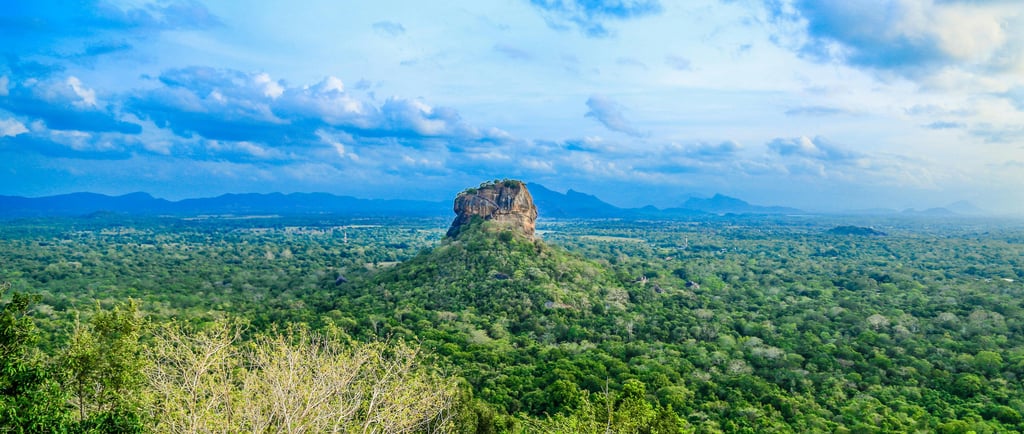Discovering Sigiriya Rock Fortress and Pidurangala Rock: Ancient History, Epic Hikes, and Stunning Views in Sri Lanka
Explore Sigiriya Rock Fortress and Pidurangala Rock in Sri Lanka tourism. Discover ancient history, epic hikes, and stunning views for an unforgettable adventure in one of the best places to visit in Sri Lanka.


Introduction
Nestled in the lush heart of Sri Lanka's Cultural Triangle, Sigiriya Rock Fortress and Pidurangala Rock stand as timeless monuments to ancient ingenuity and natural beauty. These iconic sites draw travelers from around the world, offering a blend of historical intrigue, challenging hikes, and panoramic vistas that showcase the island's rich heritage. Whether you're a history enthusiast tracing the footsteps of ancient kings or an adventurer seeking thrilling ascents, these rocks provide an immersive experience in Sri Lanka tourism. As UNESCO World Heritage sites, they highlight why Sigiriya remains one of the best places to visit in Sri Lanka, promising stories of royal drama, spiritual serenity, and breathtaking landscapes.
The Ancient History of Sigiriya Rock Fortress
Sigiriya Rock Fortress, often called the "Lion Rock," rises dramatically 200 meters above the surrounding plains, a testament to 5th-century engineering prowess. Built by King Kashyapa around 477-495 AD, this ancient citadel served as a fortified palace after the king seized power from his father in a dramatic coup. Legend has it that Kashyapa chose this imposing granite monolith for its defensive advantages, transforming it into a lavish stronghold complete with gardens, pools, and frescoes depicting celestial nymphs.
The site's history dates back even further, with evidence of monastic settlements from the 3rd century BC. However, it was Kashyapa's reign that elevated Sigiriya to its peak, featuring advanced water systems that still impress modern engineers. After the king's death, the fortress was abandoned and reclaimed by Buddhist monks until the 14th century. Today, visitors can explore remnants like the Mirror Wall, inscribed with ancient graffiti praising the site's beauty, and the massive lion's paws that once guarded the entrance—hence the name "Lion Rock."
This ancient history of Sigiriya not only captivates historians but also underscores its role in Sri Lanka tourism, where ruins blend seamlessly with the jungle, offering a window into a bygone era of royal ambition and architectural brilliance.
Pidurangala Rock: A Spiritual Haven with Epic Views
Just a short distance from Sigiriya, Pidurangala Rock offers a complementary yet distinct experience, rooted in Sri Lanka's Buddhist heritage. Dating back to the 1st-2nd century BC, Pidurangala served as a monastery for monks displaced when King Kashyapa built his palace on nearby Sigiriya. The rock houses ancient cave temples, including a reclining Buddha statue and remnants of monastic dwellings, providing a serene contrast to Sigiriya's palatial grandeur.
Unlike its more famous neighbor, Pidurangala emphasizes spiritual history, with its temple at the base requiring visitors to remove shoes and cover shoulders as a sign of respect. The site's name, meaning "offering of gold," reflects its sacred status in local folklore. For those interested in the ancient history of Sigiriya extended to Pidurangala, it's a hidden gem that reveals the interplay between royalty and religion in ancient Sri Lanka.
In terms of Sri Lanka tourism, Pidurangala attracts those seeking authenticity, with fewer crowds allowing for a more introspective visit amid the ruins and natural surroundings.
Epic Hikes: Conquering Sigiriya and Pidurangala
Hiking in Sri Lanka reaches new heights at Sigiriya Rock Fortress and Pidurangala Rock, where ascents combine physical challenge with historical discovery. The Sigiriya hike involves climbing about 1,200 steps, taking 1-2 hours round trip, through terraced gardens and past fresco galleries. It's moderately strenuous, with metal staircases aiding the steeper sections, making it accessible for most fitness levels if paced properly.
Pidurangala's hike is shorter—around 30-45 minutes—but more rugged, featuring boulder scrambling near the top without formal stairs. Start at the Pidurangala Sigiri Rajamaha Viharaya temple, where a modest entrance fee applies, and navigate through caves housing ancient artifacts before the final push.
Tips for both: Wear sturdy shoes, carry water, and apply sunscreen, as the tropical heat can intensify. Avoid midday climbs to evade crowds and high temperatures; early morning or late afternoon is ideal. For beginners in hiking in Sri Lanka, consider hiring a local guide for insights into the sites' lore, enhancing the adventure while ensuring safety.
Stunning Views and What Awaits at the Summit
The true reward of these hikes lies in the stunning views in Sigiriya. Atop Sigiriya Rock Fortress, panoramic vistas unfold over emerald jungles, distant mountains, and ancient water gardens, evoking the king's aerial domain. The summit ruins, including palace foundations and pools, offer a bird's-eye perspective on this UNESCO marvel.
Pidurangala surpasses even that, providing unobstructed sights of Sigiriya itself rising majestically from the plains—often hailed as the best viewpoint in the area. From its 199-meter peak, 360-degree landscapes include rolling hills and serene reservoirs, especially magical at sunrise or sunset when golden light bathes the scene.
These stunning views in Sigiriya make the effort worthwhile, blending natural splendor with cultural depth for an unparalleled experience in the best places to visit in Sri Lanka.
Conclusion
Sigiriya Rock Fortress and Pidurangala Rock encapsulate the essence of Sri Lanka tourism, weaving ancient history, epic hikes, and stunning views into a single, unforgettable journey. From King Kashyapa's dramatic fortress to Pidurangala's monastic tranquility, these sites offer valuable insights into the island's past while delivering physical and visual thrills. As you plan your visit, remember the practical tips: opt for the dry season, prepare for the climbs, and immerse yourself in the surroundings to maximize enjoyment.
Looking ahead, tourism in Sri Lanka continues to evolve, with sustainable practices preserving these wonders for future generations. Initiatives like eco-friendly tours and community involvement ensure sites like Sigiriya remain vibrant. For more adventures, consider exploring nearby Dambulla Cave Temples or Ella's scenic trails—perfect extensions to your itinerary. Have you visited these rocks? Share your experiences below to inspire fellow travelers—what hidden spot surprised you most?
What Is the Ancient History Behind Sigiriya Rock Fortress and Pidurangala Rock in Sri Lanka?
Sigiriya was built as a palace-fortress by King Kashyapa in the 5th century AD, with roots in earlier monastic use. Pidurangala, tied to Buddhist history since the 1st-2nd century BC, served as a monastery for displaced monks. Both highlight royal and spiritual legacies in Sri Lanka tourism.
How Difficult Are the Hikes to Sigiriya Rock Fortress and Pidurangala Rock for Beginners?
Sigiriya involves 1,200 steps over 1-2 hours, moderate with stairs. Pidurangala is shorter (30-45 minutes) but steeper with scrambling. Beginners should pace themselves, wear proper shoes, and hike early to avoid heat in hiking in Sri Lanka.
When Is the Best Time to Visit Sigiriya Rock Fortress and Pidurangala Rock in Sri Lanka?
The dry season from December to April offers ideal weather, with temperatures around 29°C. For hikes, aim for sunrise at Pidurangala and sunset at Sigiriya to beat crowds and enjoy optimal lighting.
Can You Visit Both Sigiriya Rock Fortress and Pidurangala Rock in One Day?
Yes, many visitors hike Pidurangala at dawn for views of Sigiriya, then climb Sigiriya later. Allow 4-6 hours total, including travel between sites, for a full day in the best places to visit in Sri Lanka.
What Are Some Essential Tips for First-Time Hikers at Sigiriya and Pidurangala in Sri Lanka Tourism?
Bring water, sunscreen, and insect repellent; respect temple dress codes at Pidurangala. Start early, stay hydrated, and consider a guide for historical context to enhance your epic hikes and stunning views in Sigiriya.
